
Question and Answers Forum
Question Number 38151 by ajfour last updated on 22/Jun/18
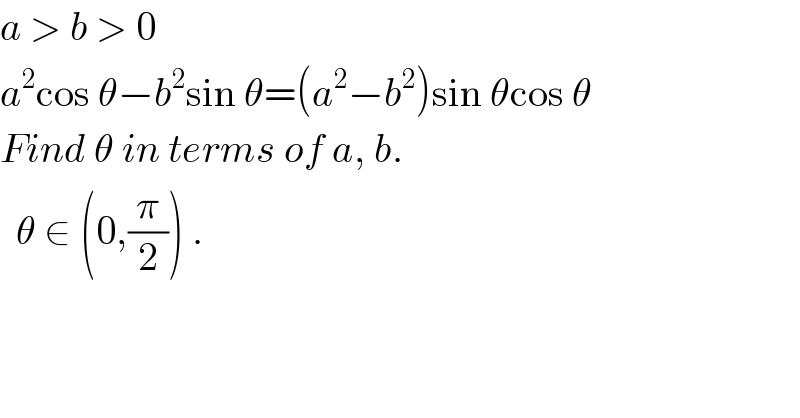
Commented bybehi83417@gmail.com last updated on 23/Jun/18
![let: m=e^(iθ) ,i=(√(−1)) ⇒a^2 .((m^2 +1)/(2m))−b^2 .((m^2 −1)/(2im))=(a^2 −b^2 )((m^4 −1)/(4im^2 )) ⇒2a^2 .m(m^2 +1)+2mib^2 (m^2 −1)=i(b^2 −a^2 )(m^4 −1) ⇒ { ((2a^2 .m(m^2 +1)=0 (A))),((2b^2 .m(m^2 −1)=(b^2 −a^2 )(m^4 −1) (B))) :} ⇒^A (a=0)∨(m=0)∨(m^2 +1)=0 a=0⇒cosθ=1⇒θ=0 ( ×) m=0⇒e^(iθ) =0 (×) m^2 +1=0⇒m=±i⇒e^(iθ) =e^(±i(π/2)) ⇒θ=±(π/2) (×) ⇒^B 2b^2 .m(m^2 −1)=(b^2 −a^2 )(m^4 −1) ⇒ { ((m^2 −1=0⇒m=±1⇒e^(iθ) =±1=e^(±iπ) )),((⇒θ=±π (×))) :}(×) 2b^2 .m=(b^2 −a^2 )(m^2 +1)⇒((m^2 +1)/(2m))=(b^2 /(b^2 −a^2 )) ((m^2 +1+2m)/(m^2 +1−2m))=((b^2 +b^2 −a^2 )/(b^2 −b^2 +a^2 ))⇒(((m+1)/(m−1)))^2 =2(b^2 /a^2 )−1 ⇒((m+1)/(m−1))=((√(2b^2 −a^2 ))/a)⇒((m+1+m−1)/(m+1−m+1))=(((√(2b^2 −a^2 ))+a)/((√(2b^2 −a^2 ))−a)) ⇒m=((b^2 +a.(√(2b^2 −a^2 )))/(b^2 −a^2 )) ⇒e^(i𝛉) =((b^2 +a.(√(2b^2 −a^2 )))/(b^2 −a^2 )) ,(p=(b^2 /a^2 )) ⇒i𝛉=ln((b^2 +a(√(2b^2 −a^2 )))/(b^2 −a^2 )) ⇒i𝛉=ln((p+(√(2p−1)))/(p−1)) .■ =ln((p/(p−1))+((√(1−2p))/(p−1)).i)= =[(1/2)ln(((p^2 +(1−2p))/((p−1)^2 )))+i.arctg(((√(1−2p))/(p−1))/(p/(p−1)))]= =[(1/2)ln1+i.arctg((√(1−2p))/p)]=i.arctg((√(1−2p))/p) ⇒𝛉=arctg((√(1−2p))/p)=arctg((a.(√(a^2 −2b^2 )))/b^2 ).■ sir Ajfour! this is a real solution for your quistion.](Q38187.png)
Commented byajfour last updated on 23/Jun/18

Commented byMJS last updated on 23/Jun/18

Commented bybehi83417@gmail.com last updated on 23/Jun/18

Commented byMJS last updated on 23/Jun/18
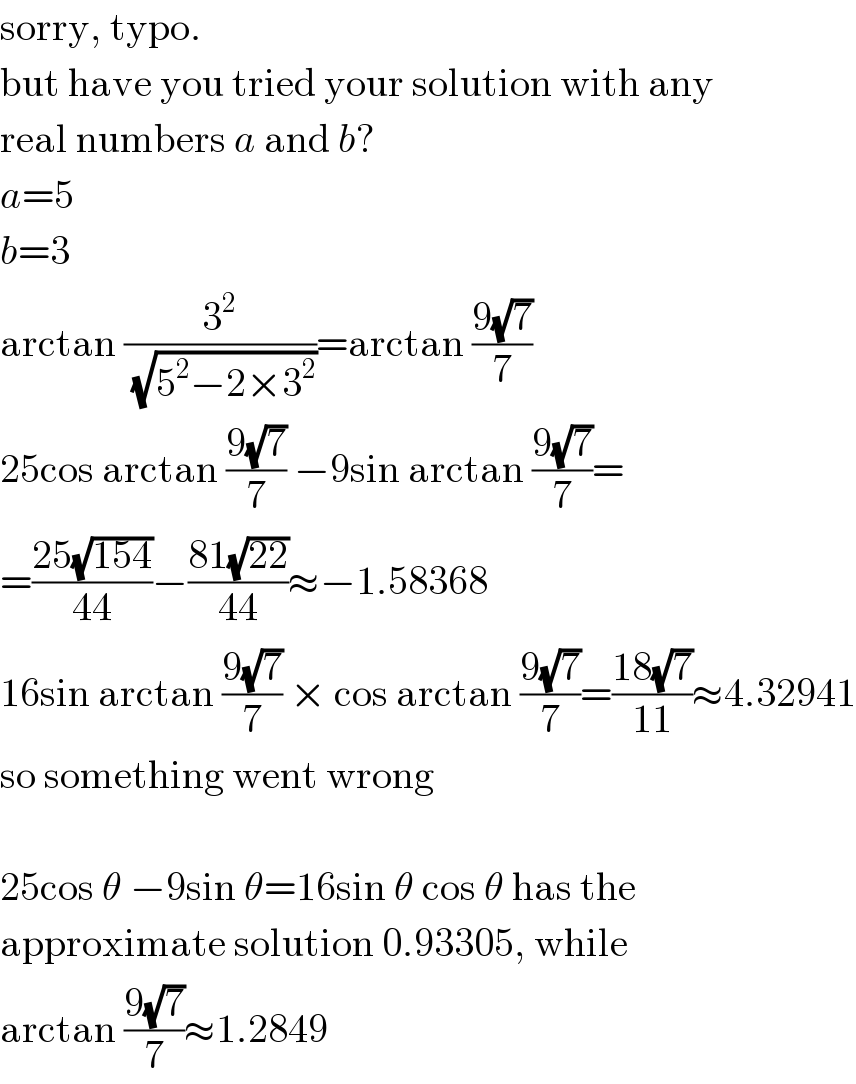
Commented byMJS last updated on 23/Jun/18
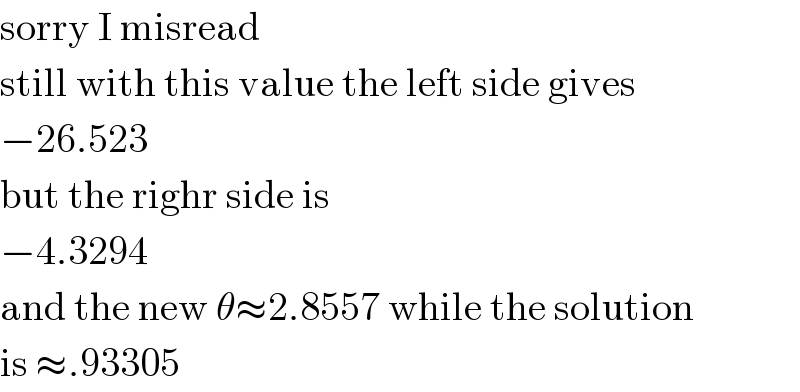
Commented bybehi83417@gmail.com last updated on 23/Jun/18

Commented byMJS last updated on 24/Jun/18
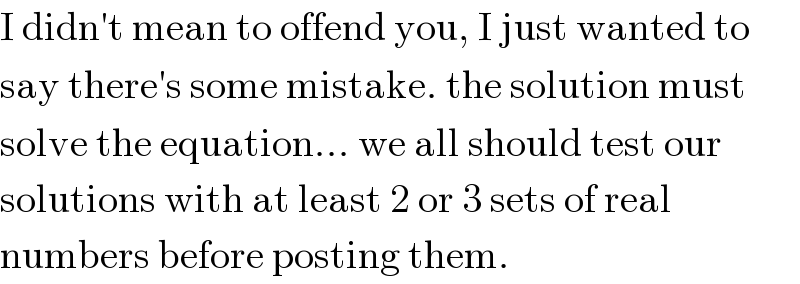
Answered by tanmay.chaudhury50@gmail.com last updated on 22/Jun/18
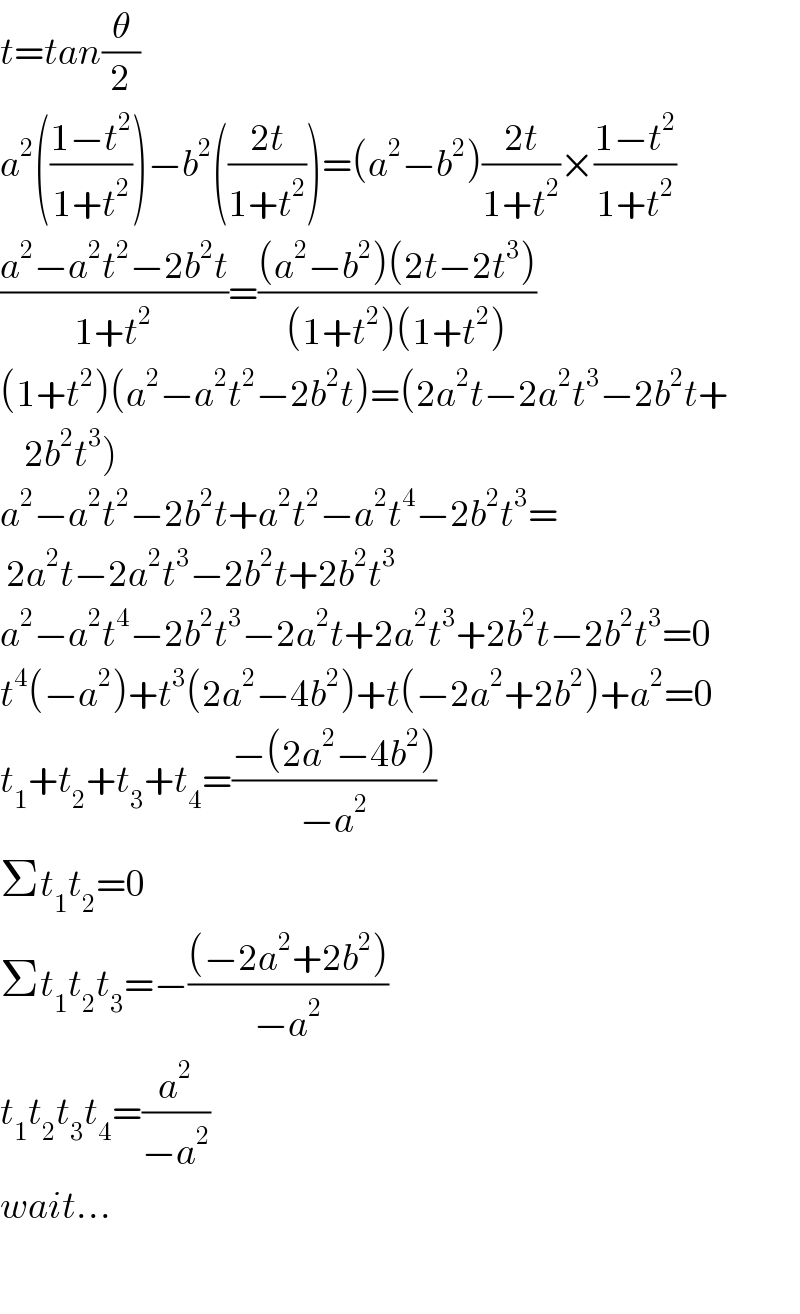
Commented bymath khazana by abdo last updated on 22/Jun/18

Commented byrahul 19 last updated on 22/Jun/18
��������
Answered by ajfour last updated on 23/Jun/18
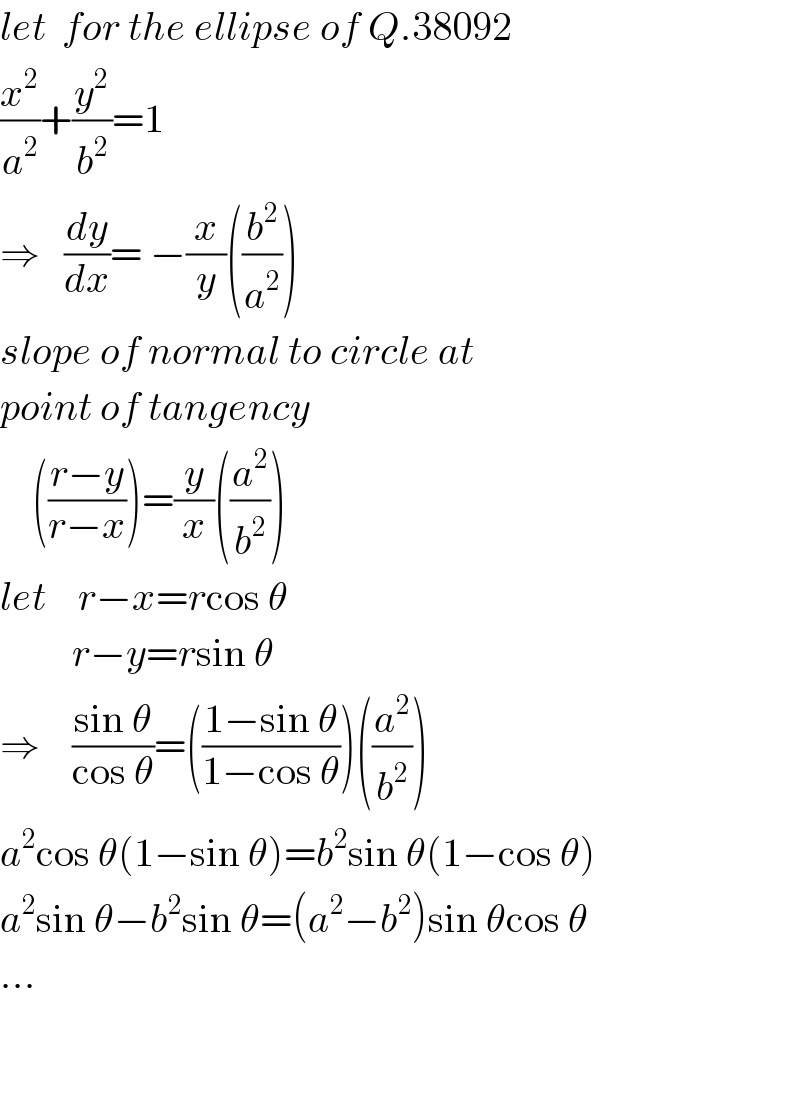
Answered by MJS last updated on 25/Jun/18
![it′s not nice and probably not useable but it′s possible let a=1 and b^2 =q (q=(b^2 /a^2 )) cos θ −qsin θ −(1−q)sin θ cos θ =0 θ=2arctan t −((t^4 +2(2q−1)t^3 +2t−1)/(t^4 +2t^2 +1))=0 t^4 +2t+1=0 ⇒ t=±i ∉R ⇒ we can multiplicate without further trouble t^4 +2(2q−1)t^3 +2t−1=0 approximate solving with some values of q leads to the conclusion that this has two complex and two real solutions. the complex ones must be α+βi and α−βi and I hope the real ones are γ+δ and γ−δ. (t−α−βi)(t−α+βi)(t−γ−δ)(t−γ+δ)=0 t^4 − −2(α+γ)t^3 + +(α^2 +4ϑγ+β^2 +γ^2 −δ^2 )t^2 − −2(α^2 γ+αγ^2 −αδ^2 +β^2 γ)t+ +(α^2 +β^2 )(γ^2 −δ^2 )=0 ⇒ [1] 2(2q−1)=−2(α+γ) [2] 0=α^2 +4ϑγ+β^2 +γ^2 −δ^2 [3] 2=−2(α^2 γ+αγ^2 −αδ^2 +β^2 γ) [4] −1=(α^2 +β^2 )(γ^2 −δ^2 ) [1] α=−γ−2q+1 [2] β=(√(−α^2 −4αγ−γ^2 +δ^2 ))= =(√(2γ^2 +(4q−2)γ+δ^2 −(2q−1)^2 )) [3] 2=−4γ^3 +(6−12q)γ^2 −2(2γ+2q−1)δ^2 ⇒ ⇒ δ=(√(−((2γ^3 +3(2q−1)γ^2 +1)/(2γ+2q−1)))) ⇒ β=(√((2γ^3 +3(2q−1)γ^2 −2q(4q^2 −6q+3))/(2γ+2q−1))) [4] −1=((16γ^6 +48(2q−1)γ^5 +48(2q−1)^2 γ^4 +16(2q−1)^3 γ^3 +4(2q−1)γ^2 +4(2q−1)^2 γ−1)/((2γ+2q−1)^2 )) [γ≠(1/2)−q; this will be fulfilled with q=((1−(2)^(1/3) )/2)<0 so we don′t have to care] γ^6 +3(2q−1)γ^5 +3(2q−1)^2 γ^4 +(2q−1)^3 γ^3 +(q/2)γ^2 +((q(2q−1))/2)γ+((q(q−1))/4)=0 at this point we can only try to omit the γ^5 by setting γ=u−((3(2q−1))/6)=u−q+(1/2) which leads to u^6 −((3(2q−1)^2 )/4)u^4 +((48q^4 −96q^3 +72q^2 −16q+3)/(16))u^2 −(((8q^3 −12q^2 +6q+1)^2 )/(64))=0 we seem to have good luck set u=(√v) v^3 −((3(2q−1)^2 )/4)v^2 +((48q^4 −96q^3 +72q^2 −16q+3)/(16))v−(((8q^3 −12q^2 +6q+1)^2 )/(64))=0 omit v^2 by setting v=w−(((2q−1)^2 )/4) leads to w^3 +(q/2)w+((q(q−1))/4)=0 [x^3 +Px+Q=0 ⇒ ⇒ x_1 =((−(Q/2)+(√((P^3 /(27))+(Q^2 /4)))))^(1/3) +((−(Q/2)−(√((P^3 /(27))+(Q^2 /4)))))^(1/3) ] w_1 =((q)^(1/3) /2)(((1−q+(√((q−1)^2 +((8q)/(27))))))^(1/3) +((1−q−(√((q−1)^2 +((8q)/(27))))))^(1/3) ) (q−1)^2 +((8q)/(27))>0 ∀q>0 ⇒ w_1 ∈R ∀ q>0 ...now we have to set q and go all the way back... solutions of polynomes of 4^(th) degree usually are even worse...](Q38381.png)
Commented byajfour last updated on 25/Jun/18

Commented byMJS last updated on 25/Jun/18

Commented byMJS last updated on 25/Jun/18
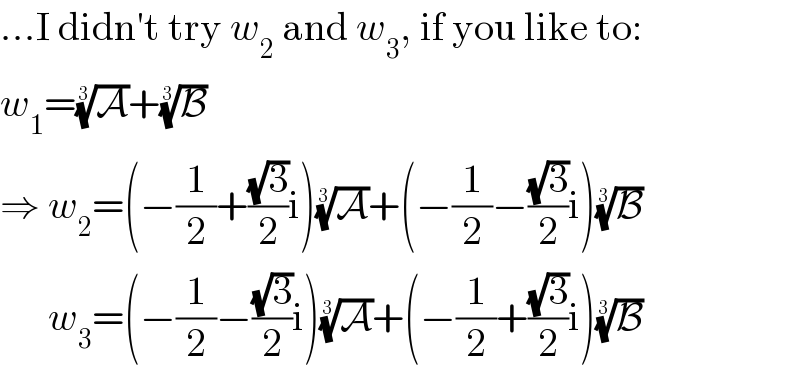
Commented byajfour last updated on 26/Jun/18

